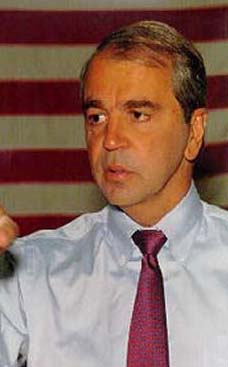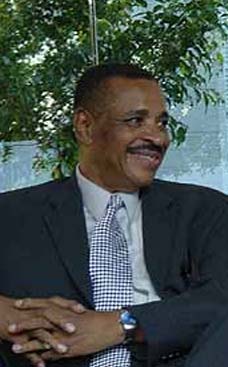
Thilly, now in his 14th year as president of Wisconsin Public Power Inc., says his company's role as a collective market force working on behalf of member cities such as Stoughton and Mount Horeb is more important than ever.
Philippines RPCV Roy Thilly is a big believer in community-owned power companies
Keeping costs low as they can
00:00 am 8/07/05
Ben Fischer Wisconsin State Journal
Roy Thilly is a big believer in community-owned power companies, even - or especially - as bigger, publicly traded utilities grow into giants capitalizing on the world's skyrocketing energy needs.
Thilly, now in his 14th year as president of Wisconsin Public Power Inc., says his company's role as a collective market force working on behalf of member cities such as Stoughton and Mount Horeb is more important than ever.
After a stint in the Peace Corps and a law degree from UW-Madison in 1974, he's spent his entire professional life knee-deep in Wisconsin energy concerns, working to create WPPI in the late 1970s and then representing the company as a lawyer for more than a decade before taking the helm.
Utilities everywhere, including Sun Prairie-based WPPI, are building costly plants and pushing technological limits on efficient and clean fuels. The insiders call it a "building cycle," and it means bigger bills for everyone.
Q: How does the current building cycle and trend of in creased costs affect the cus tomers of WPPI differently from customers of traditional utilities?
A: The general level of our costs will track the level of costs for utilities in Wisconsin, because we're all using the same fuel. We're essentially buying power or generating power from very similar power plants. But WPPI members and their customers can be confident that we have a single purpose, which is to keep those costs as manageable as we can.
We don't have any conflict with the interest of trying to raise share price or return to shareholders. So I think our single focus is a benefit. We're also not looking at whether we should invest in plants or do things in other countries or other states.
Q: The company started with 23 cities in 1980. Now there are 40. Are you plan ning on growing the member ship further?
A: We are open to membership by any of the municipal electric utilities in the state, and there are 82 total. So, the answer is yes, but we don't go out and try to recruit new members. When you come to WPPI, you make a long-term commitment to ownership of generation. You sign a long- term contract and we want members who believe that joint action, moving together, developing our resources is the right answer. They come when they're convinced of that rather than our going out and trying to sell them.
So we've seen some growth recently, I think we'll see some more growth. Power markets are becoming much more complex, economies of scale and size are very important,and so I think what we see is small towns that have their own utilities starting to realize that going it alone is going to be very tough.
Q: What's next for WPPI?
A: Today, we're focused on major new investment. WPPI has about $180 million in debt. If we move forward with two major power plants, there will be interest in four power plants that will be before our board in September. Our debt will increase by almost $400 million. So those are very big decisions for us.
We're looking at investing at the plants in Oak Creek, and in addition, two coal-fired units in Illinois.
Q: Even with wind and other alternative energy sources becoming more pop ular, many new projects are still based in coal, including the plants in Oak Creek that sparked controversy. Explain why coal is still necessary. Why not just use wind for all of your new plants?
A: We don't have the wind resources that come close to meeting our requirements. It can play an important role and will play an important role, but it's not the answer to our energy needs. And the other choice is natural gas, where the price is very volatile and high. But the other thing is, we need natural gas for home heating and a lot of industrial uses. And the more electric generation competes with gas, it's going to push up the price of home heating, that's going to push up the price of industrial uses, and on top of that, we don't have the pipeline capacity for a lot of new major gas units. So there's a lot of reasons not to do that.
We have an abundant coal supply in this country, and the challenge is to find a way to use that coal to produce energy in a way that is as environmentally benign as we can do it.
Q: Last year's report from Gov. Jim Doyle's energy task force was highly touted as a good blueprint for more con servation and energy effi ciency, and industry leaders have promised to work to comply. But you've advocated an even stronger stance. What more needs to happen?
A: Wisconsin doesn't have any indigenous energy resources. There's no gas or coal in the ground, our wind resources are average at best, so we have to bring in all our energy, which means all the money flows out. We're facing increasing costs which are not going to taper off for some time. So not wasting energy should be a business priority for the state, for its economic development and its health.
In order to get there, we have only relied on utility- funded programs, putting some money in rates and having educational programs and programs for rebates. But if you really want to make a strong dent, you need much stronger building codes and appliance efficiencies. Those types of measures bring real and measurable results that will be significantly higher in impact. But that takes a lot of political will.
Q: The American Transmis sion Co., a company you help run as a board member, has plans to invest more than $1 billion in new lines statewide in coming years. Why is that new investment needed?
A: Clearly, having more import capability and less constraints on the transmission system will keep rates down. If you look at the prices, the price in Wisconsin is every hour, every 10 minutes, always higher than it is in the adjacent states. It's highest in the Upper Peninsula, which has an even weaker transmission system than we do, but ours is always high, and always more volatile.
If we want to have prices that are equivalent to other states, the people we're competing with for jobs and everything else, we need a transmission system that puts us in the same level, with free and open access, and that will keep rates low and stable.
That isn't going to convince the guy who, unfortunately, has a new power line going by his farm or house, and there's nothing you can do about that. Putting them underground costs 10 to 15 times as much. It's just not viable.
Contact reporter Ben Fischer at bfischer@madison.com or 252-6123. Roy Thilly President and chief executive, Wisconsin Public Power Inc. Employees: 78 Year founded: 1980 Annual revenue: $223 million Member communities in Dane County: Waunakee, Sun Prairie, Mount Horeb, Stoughton (40 total statewide) Age: 58 Education: UW-Madison Law School, 1974; Bachelor of Arts in English, Columbia College, 1968. Family: Wife, Mary; children, Helen, Owen and Peter.











